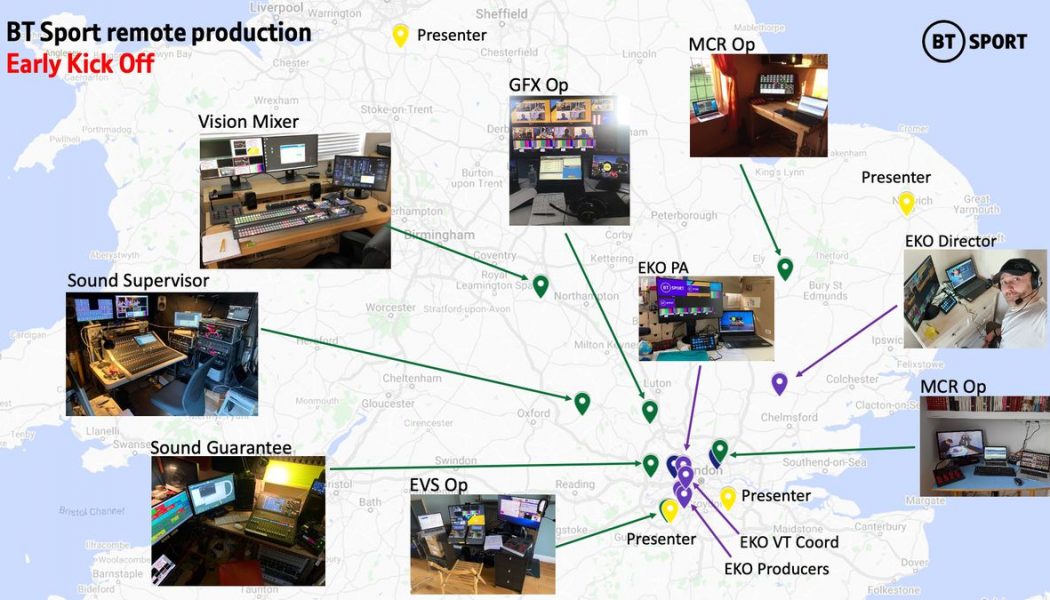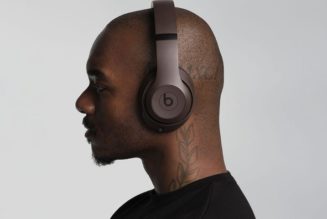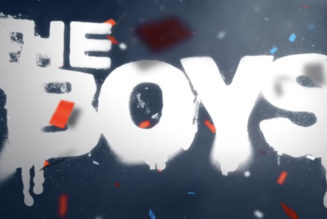As governments across Europe begin to ease lockdown restrictions and allow sport to return during a pandemic, a production team in the UK has quietly been getting ready. BT Sport, which typically produces and broadcasts live Premier League football (soccer) in 4K HDR on a weekly basis, has moved nearly all of its production team remote. Live football returns in Europe this weekend for Germany’s Bundesliga, and producers, directors, and commentators will go live in makeshift home offices just a few steps away from where they usually sleep.
“We’ve been doing 7 live shows every week during lockdown all remotely,” says Jamie Hindhaugh, chief operating officer at BT Sport, in an interview with The Verge. “You learn different tricks and traits, and you understand how different people interpret what you’re saying.” These smaller live shows have been a learning curve, allowing the production team to create a virtual TV studio and prepare for the return of live football. That’s involved moving kit that would normally be operated in the back of a van or studio into people’s living rooms and garages.
BT Sport’s production team is typically stationed in an office in Stratford, East London, and they’re often at the cutting edge of tech like 8K broadcasting. But nearly all of the team is now working remotely after the UK government implemented stay-at-home guidelines nearly two months ago. We’ve seen British TV networks and live entertainment shows adapt to the new rules in varying ways in recent weeks, with some shows halting production altogether and others carrying on in environments where it looks, to the viewer at least, like there’s little social distancing going on.
:no_upscale()/cdn.vox-cdn.com/uploads/chorus_asset/file/19980138/BTSportRemoteProduction_EarlyKick_off.jpeg)
“We were determined from day one to recognize we’re a sports network, not a news network,” explains Hindhaugh. “It was critical we showed empathy to our audiences and therefore behaved under the same constraints that our audiences have. That’s why you’ve seen it all coming from home, with no travel. I didn’t feel it was right for us to be looking at how we get around that.”
Producing live sport is no easy task, and there’s a team of producers, directors, and operators involved that make things like action replays and motion graphics instantly appear on your TV screen at home. A lot of the kit that’s used, like vision mixers or sound recording mixers, has been moved into people’s homes in recent weeks.
“The kit’s smaller than you think, because it’s the top layer that gets separated out,” says Hindhaugh. “So the servers and everything are still in Stratford.” A lot of the challenges have been around syncing everything up and separating what’s typically used in a studio to work across 4G connectivity or home broadband connections. “The same vision mixer we use in a studio, the front top end of that is now in a director’s house, so you’re controlling the main vision mixer in the studio remotely,” reveals Hindhaugh. “It’s like you’re driving a car, but you’re in a simulator.”
:no_upscale()/cdn.vox-cdn.com/uploads/chorus_asset/file/19980140/EVSOp1.jpg)
The teams are also still able to communicate with each other in real time to make all-important split-second decisions using the same talk back intercom system they’ve been using for years. “Talk back is critical, to be able to hear people properly,” explains Hindhaugh. “As long as you’ve got talk back and you’ve got the tool, the reality is you should be able to do it [remotely].”
BT Sport is planning to air seven games tomorrow, with the main show including two presenters in a studio in London. Six members of staff will be part of the studio for the main game, including a camera operator, to ensure output is maintained, but all other producers and directors will be doing their part from their homes.
Another two games will be produced and directed completely from people’s homes, with commentators also based at home. “There will be three people producing each game, all remotely, all going out live,” says Hindhaugh. For the five live games that BT Sport is handling the production for, Hindhaugh says “we’ll have less than 10 people on site.”
Presenters and commentators have had to get used to doing some of the production aspects on their own at home in recent weeks. BT Sport has shipped out cameras or even used smartphones to broadcast interviews, depending on connectivity and how comfortable presenters are at operating camera setups.
:no_upscale()/cdn.vox-cdn.com/uploads/chorus_asset/file/19980142/EKODirector.jpg)
Surprisingly, none of this remote production will mean a delay in what viewers see on-screen. Commentary, action replays, graphics, and everything you normally expect to see and hear should just work like normal.
The transition for BT Sport to remote production is something that the team is planning to keep going, regardless of the pandemic. “I don’t think we will ever work the same we were 10 weeks ago, and I see that as really positive,” explains Hindhaugh. “After fighting it for 6 weeks and accepting it, all of a sudden I’m like ‘well I see my kids every night, I get all my work done like I did before, and if anything I’m more productive.’ It’s not just a broadcast thing, working from home has always been questioned, and actually I think there is now an acceptance that it does work and you know what, people like it.”
BT Sport had been planning to gradually transition some of this work to remote over the next four years, but the pandemic has certainly sped that up. “One of our key concerns as an organization was around the green agenda and sustainability, and the only way we see where we could really cut the impact on what we do on the environment was going remote,” says Hindhaugh. “You look around you and the air feels cleaner. I’m desperate that we embrace this, and I think we will as an industry, to help us become a more sustainable industry.”
So, here is how we will broadcast TV to you, despite the lockdown…not a single person leaving their home, no-one with 2 metres of me, and all using the 4G network. There are some clever people out there. ❤️ pic.twitter.com/FoePpk3om7
— Jake Humphrey (@mrjakehumphrey) March 26, 2020
Hindhaugh believes this moment is also a boost to diversity and inclusion efforts, as companies will be able to attract more staff with the ability to offer them a work and life balance that doesn’t involve hours of travel each day.
This weekend’s Bundesliga also includes challenges around social distancing on the pitch and in stands where fans usually cheer on a home team and taunt their rivals. This all adds to the atmosphere of a game when you’re watching on TV, and as games are being played behind closed doors, that element will certainly be missing.
BT Sport is looking into what it can do around the lack of atmosphere for when the Premier League returns and it has greater control over match coverage. “I think at the moment we’ll be reflecting the atmosphere that’s there,” says Hindhaugh. “It’s going to be quite intriguing as a football fan because you are going to hear the tactics a bit more.”
Crowd effects could be one way to add atmosphere, but it seems to be something BT Sport is keen to avoid. “When you start adding sound effects and crowd noise, it becomes a little surreal,” says Hindhaugh. “We’re looking at all of those options, and one thing I can say to you is if the Premier League does come back we’ll definitely explore options for our audiences.”
It’s clear there’s a big appetite for football leagues to return, with South Korea’s top-flight league attracting 3.4 million viewers on Twitter alone last weekend. It’s now a big test for live football returning in Europe this weekend and a showcase for how TV production is changing during this pandemic. “It puts the ball back in production and creative colleagues hands,” says Hindhaugh. “Technology should always be enabling, it shouldn’t be driving. This shows you can get flexibility, and you can start giving our creative colleagues the opportunity to do what they want to do in different ways. I think it’s exciting.”








